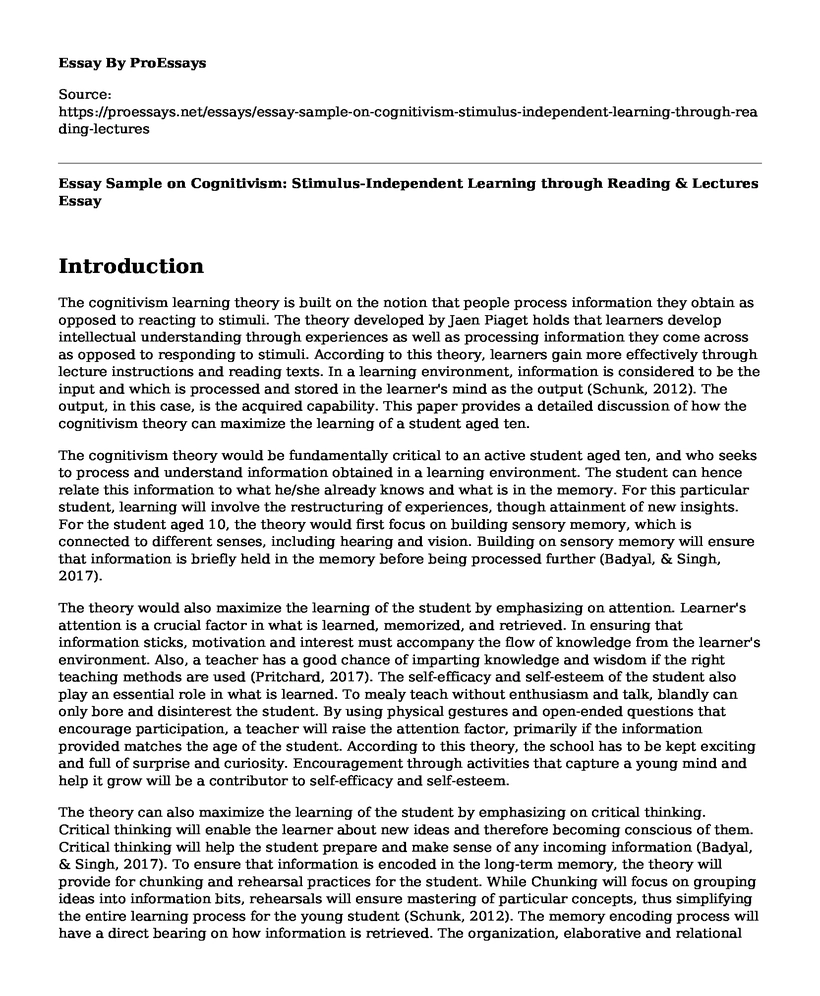Introduction
The cognitivism learning theory is built on the notion that people process information they obtain as opposed to reacting to stimuli. The theory developed by Jaen Piaget holds that learners develop intellectual understanding through experiences as well as processing information they come across as opposed to responding to stimuli. According to this theory, learners gain more effectively through lecture instructions and reading texts. In a learning environment, information is considered to be the input and which is processed and stored in the learner's mind as the output (Schunk, 2012). The output, in this case, is the acquired capability. This paper provides a detailed discussion of how the cognitivism theory can maximize the learning of a student aged ten.
The cognitivism theory would be fundamentally critical to an active student aged ten, and who seeks to process and understand information obtained in a learning environment. The student can hence relate this information to what he/she already knows and what is in the memory. For this particular student, learning will involve the restructuring of experiences, though attainment of new insights. For the student aged 10, the theory would first focus on building sensory memory, which is connected to different senses, including hearing and vision. Building on sensory memory will ensure that information is briefly held in the memory before being processed further (Badyal, & Singh, 2017).
The theory would also maximize the learning of the student by emphasizing on attention. Learner's attention is a crucial factor in what is learned, memorized, and retrieved. In ensuring that information sticks, motivation and interest must accompany the flow of knowledge from the learner's environment. Also, a teacher has a good chance of imparting knowledge and wisdom if the right teaching methods are used (Pritchard, 2017). The self-efficacy and self-esteem of the student also play an essential role in what is learned. To mealy teach without enthusiasm and talk, blandly can only bore and disinterest the student. By using physical gestures and open-ended questions that encourage participation, a teacher will raise the attention factor, primarily if the information provided matches the age of the student. According to this theory, the school has to be kept exciting and full of surprise and curiosity. Encouragement through activities that capture a young mind and help it grow will be a contributor to self-efficacy and self-esteem.
The theory can also maximize the learning of the student by emphasizing on critical thinking. Critical thinking will enable the learner about new ideas and therefore becoming conscious of them. Critical thinking will help the student prepare and make sense of any incoming information (Badyal, & Singh, 2017). To ensure that information is encoded in the long-term memory, the theory will provide for chunking and rehearsal practices for the student. While Chunking will focus on grouping ideas into information bits, rehearsals will ensure mastering of particular concepts, thus simplifying the entire learning process for the young student (Schunk, 2012). The memory encoding process will have a direct bearing on how information is retrieved. The organization, elaborative and relational referencing to the myriad of networks will allow for comparative analysis and retrieval. On the higher end, the theory will focus on information retrieval. The retrieval process will enable the learner to remember any information learned in the past to make responses.
Conclusion
In conclusion, the cognitivism theory will enable young learners to process new information while they also learn to make personal decisions with their minds influencing the decisions. Additionally, the theory will allow young students to communicate effectively with their educational goals and desires as well as process massive data into valuable information (Pritchard, 2017). Behavioral changes on the learner are observed to act as an indicator of what is transpiring in mind. In this case, the brain serves as a reflector from which acquired skills and knowledge are mirrored.
References
Badyal, D. K., & Singh, T. (2017). Learning theories: the basics to learn in medical education. International Journal of Applied and Basic Medical Research, 7(Suppl 1), S1.
Kelly, J. (2012, September 16). Learning theories Behaviorism, Cognitive, and Constructivist. Retrieved from http://thepeakperformancecenter.com/educational-learning/learning/theories/
Pritchard, A. (2017). Ways of learning: Learning theories for the classroom. Routledge.
Schunk, D. H. (2012). Learning theories: an educational perspective. Boston, MA: Pearson Education, Inc.
Cite this page
Essay Sample on Cognitivism: Stimulus-Independent Learning through Reading & Lectures. (2023, Feb 13). Retrieved from https://proessays.net/essays/essay-sample-on-cognitivism-stimulus-independent-learning-through-reading-lectures
If you are the original author of this essay and no longer wish to have it published on the ProEssays website, please click below to request its removal:
- A Review of an Individual Educational Program (IEP)
- The Language Instinct: How the Mind Creates Language
- Social Autobiography Annotated Bibliography
- Why Standardized Testing in Schools is not Beneficial to Education? - Argumentative Essay
- Essay Example: Is Food Coloring Safe for Kids?
- Essay Example on Nurturing Young Minds: Unlocking Brilliance in Kids Ages 2-8
- Paper Example on Zackery: A Seven-Year-Old Boy with an Excellent Performance in School







